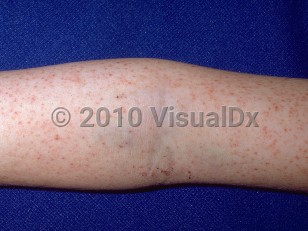Potentially life-threatening emergency
Rocky Mountain spotted fever in Child
Alerts and Notices
Important News & Links
Synopsis

Rocky Mountain spotted fever (RMSF) is a rapidly progressive and often fatal infection caused by the obligate intracellular gram-negative bacterium Rickettsia rickettsii. It is the most severe rickettsial illness in humans; without treatment, the case fatality rate is 20%-30%.
The disease, one of the Spotted Fever Group (SFG) of rickettsioses, is transmitted exclusively via tick vectors: the American dog tick (Dermacentor variabilis) in the eastern United States (US); the Rocky Mountain wood tick (D andersoni) in the Rocky Mountain states; the brown dog tick (Rhipicephalus sanguineus) in the Southwest US; and the cayenne tick (Amblyomma sculptum) in Brazil. Mucosal transmission can occur when contaminated by a crushed tick or by tick fecal matter. RMSF occurs over a wide distribution throughout the contiguous US, but cases are most commonly reported from Arkansas, Missouri, North Carolina, Oklahoma, and Tennessee, with a recent cluster of cases reported in Arizona. RMSF can also be seen in northern Mexico and Central and South America.
Rickettsia sp CA6269 is a newly recognized rickettsial pathogen reported to have caused 2 cases of severe RMSF-like illness in northern California. Both patients experienced severe clinical manifestations shared with RMSF (acute kidney injury, respiratory failure, cutaneous necrosis and gangrene, and encephalitis), and both patients likely acquired the infections locally from tick bites during outdoor activities.
Over 90% of cases occur during April through September. The disease is more frequent in males and children.
The incidence of RMSF has been steadily increasing to an estimated 2000 cases per year, but the case fatality rates (in the US) have been decreasing (attributed to enhanced recognition and early treatment).
Early clinical manifestations of RMSF include high fever, severe headache, myalgias, nausea, and vomiting. Later manifestations include rash, photophobia, confusion, ataxia, seizures, cough, dyspnea, arrhythmias, jaundice, and severe abdominal pain. Rash occurs more frequently in children and young adults than in older individuals. It is also seen earlier in the course of the disease in the young than in older individuals. Thrombocytopenia, hyponatremia, and acute respiratory distress syndrome with organ failure may also be seen. A further complication of RMSF is rhabdomyolysis. Long-term sequelae may include amputations as well as neurological consequences including, in addition to ataxia, impaired speech, dysphagia, and memory loss.
The disease, one of the Spotted Fever Group (SFG) of rickettsioses, is transmitted exclusively via tick vectors: the American dog tick (Dermacentor variabilis) in the eastern United States (US); the Rocky Mountain wood tick (D andersoni) in the Rocky Mountain states; the brown dog tick (Rhipicephalus sanguineus) in the Southwest US; and the cayenne tick (Amblyomma sculptum) in Brazil. Mucosal transmission can occur when contaminated by a crushed tick or by tick fecal matter. RMSF occurs over a wide distribution throughout the contiguous US, but cases are most commonly reported from Arkansas, Missouri, North Carolina, Oklahoma, and Tennessee, with a recent cluster of cases reported in Arizona. RMSF can also be seen in northern Mexico and Central and South America.
Rickettsia sp CA6269 is a newly recognized rickettsial pathogen reported to have caused 2 cases of severe RMSF-like illness in northern California. Both patients experienced severe clinical manifestations shared with RMSF (acute kidney injury, respiratory failure, cutaneous necrosis and gangrene, and encephalitis), and both patients likely acquired the infections locally from tick bites during outdoor activities.
Over 90% of cases occur during April through September. The disease is more frequent in males and children.
The incidence of RMSF has been steadily increasing to an estimated 2000 cases per year, but the case fatality rates (in the US) have been decreasing (attributed to enhanced recognition and early treatment).
Early clinical manifestations of RMSF include high fever, severe headache, myalgias, nausea, and vomiting. Later manifestations include rash, photophobia, confusion, ataxia, seizures, cough, dyspnea, arrhythmias, jaundice, and severe abdominal pain. Rash occurs more frequently in children and young adults than in older individuals. It is also seen earlier in the course of the disease in the young than in older individuals. Thrombocytopenia, hyponatremia, and acute respiratory distress syndrome with organ failure may also be seen. A further complication of RMSF is rhabdomyolysis. Long-term sequelae may include amputations as well as neurological consequences including, in addition to ataxia, impaired speech, dysphagia, and memory loss.
Codes
ICD10CM:
A77.0 – Spotted fever due to Rickettsia rickettsii
SNOMEDCT:
186772009 – Rocky Mountain spotted fever
A77.0 – Spotted fever due to Rickettsia rickettsii
SNOMEDCT:
186772009 – Rocky Mountain spotted fever
Look For
Subscription Required
Diagnostic Pearls
Subscription Required
Differential Diagnosis & Pitfalls

To perform a comparison, select diagnoses from the classic differential
Subscription Required
Best Tests
Subscription Required
Management Pearls
Subscription Required
Therapy
Subscription Required
References
Subscription Required
Last Reviewed:05/21/2024
Last Updated:06/02/2024
Last Updated:06/02/2024

